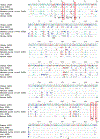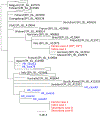Infection of dogs with SARS-CoV-2
- PMID: 32408337
- PMCID: PMC7606701
- DOI: 10.1038/s41586-020-2334-5
Infection of dogs with SARS-CoV-2
Abstract
Severe acute respiratory syndrome coronavirus 2 (SARS-CoV-2) was first detected in Wuhan in December 2019 and caused coronavirus disease 2019 (COVID-19)1,2. In 2003, the closely related SARS-CoV had been detected in domestic cats and a dog3. However, little is known about the susceptibility of domestic pet mammals to SARS-CoV-2. Here, using PCR with reverse transcription, serology, sequencing the viral genome and virus isolation, we show that 2 out of 15 dogs from households with confirmed human cases of COVID-19 in Hong Kong were found to be infected with SARS-CoV-2. SARS-CoV-2 RNA was detected in five nasal swabs collected over a 13-day period from a 17-year-old neutered male Pomeranian. A 2.5-year-old male German shepherd was positive for SARS-CoV-2 RNA on two occasions and virus was isolated from nasal and oral swabs. Antibody responses were detected in both dogs using plaque-reduction-neutralization assays. Viral genetic sequences of viruses from the two dogs were identical to the virus detected in the respective human cases. The dogs remained asymptomatic during quarantine. The evidence suggests that these are instances of human-to-animal transmission of SARS-CoV-2. It is unclear whether infected dogs can transmit the virus to other animals or back to humans.
Conflict of interest statement
Competing financial interests:
Authors declare no competing financial interests.
Figures



Similar articles
-
Potential infectious risk from the pets carrying SARS-CoV-2.Travel Med Infect Dis. 2020 May-Jun;35:101737. doi: 10.1016/j.tmaid.2020.101737. Epub 2020 May 5. Travel Med Infect Dis. 2020. PMID: 32380152 Free PMC article. No abstract available.
-
From People to Panthera: Natural SARS-CoV-2 Infection in Tigers and Lions at the Bronx Zoo.mBio. 2020 Oct 13;11(5):e02220-20. doi: 10.1128/mBio.02220-20. mBio. 2020. PMID: 33051368 Free PMC article.
-
Transmission of severe acute respiratory syndrome coronavirus 2 (SARS-CoV-2) to animals: an updated review.J Transl Med. 2020 Sep 21;18(1):358. doi: 10.1186/s12967-020-02534-2. J Transl Med. 2020. PMID: 32957995 Free PMC article. Review.
-
Can companion animals become infected with Covid-19?Vet Rec. 2020 Mar 28;186(12):388-389. doi: 10.1136/vr.m1194. Vet Rec. 2020. PMID: 32221002 No abstract available.
-
[Source of the COVID-19 pandemic: ecology and genetics of coronaviruses (Betacoronavirus: Coronaviridae) SARS-CoV, SARS-CoV-2 (subgenus Sarbecovirus), and MERS-CoV (subgenus Merbecovirus).].Vopr Virusol. 2020;65(2):62-70. doi: 10.36233/0507-4088-2020-65-2-62-70. Vopr Virusol. 2020. PMID: 32515561 Review. Russian.
Cited by
-
Study on sentinel hosts for surveillance of future COVID-19-like outbreaks.Sci Rep. 2024 Oct 19;14(1):24595. doi: 10.1038/s41598-024-76506-7. Sci Rep. 2024. PMID: 39427096 Free PMC article.
-
Safety and immunogenicity of a SARS-CoV-2 mRNA vaccine (SYS6006) in minks, cats, blue foxes, and raccoon dogs.Front Cell Infect Microbiol. 2024 Sep 19;14:1468775. doi: 10.3389/fcimb.2024.1468775. eCollection 2024. Front Cell Infect Microbiol. 2024. PMID: 39364147 Free PMC article.
-
Ultrafast and high-throughput immunoassay assay to detect anti-SARS-CoV-2 IgG antibodies in dogs and cats.Braz J Microbiol. 2024 Sep 20. doi: 10.1007/s42770-024-01518-4. Online ahead of print. Braz J Microbiol. 2024. PMID: 39302629
-
The comparison of pathogenicity among SARS-CoV-2 variants in domestic cats.Sci Rep. 2024 Sep 18;14(1):21815. doi: 10.1038/s41598-024-71791-8. Sci Rep. 2024. PMID: 39294189 Free PMC article.
-
Surveillance strategies for SARS-CoV-2 infections through one health approach.Heliyon. 2024 Aug 30;10(17):e37128. doi: 10.1016/j.heliyon.2024.e37128. eCollection 2024 Sep 15. Heliyon. 2024. PMID: 39286214 Free PMC article. Review.
References
-
- World Health Organization. Coronavirus disease 2019 (COVID-19) Situation Report – 50. https://www.who.int/docs/default-source/coronaviruse/situation-reports/2....
-
- WHO (2003) Consensus document on the epidemiology of severe acute respiratory syndrome (SARS) available at https://apps.who.int/iris/bitstream/handle/10665/70863/WHO_CDS_CSR_GAR_2...
Publication types
MeSH terms
Substances
Grants and funding
LinkOut - more resources
Full Text Sources
Other Literature Sources
Medical
Molecular Biology Databases
Miscellaneous

